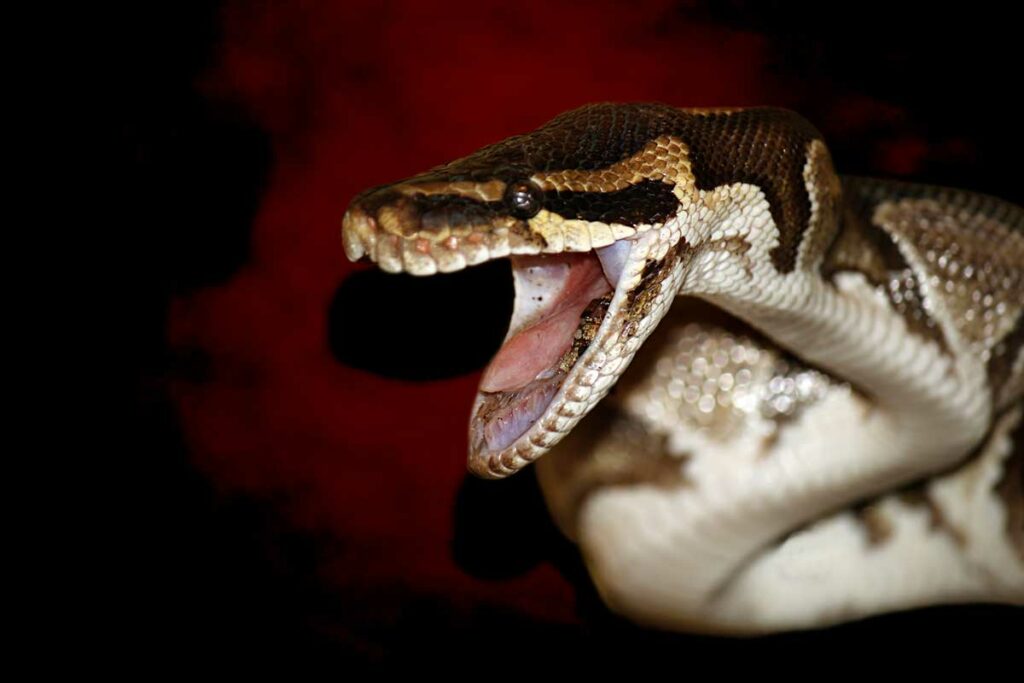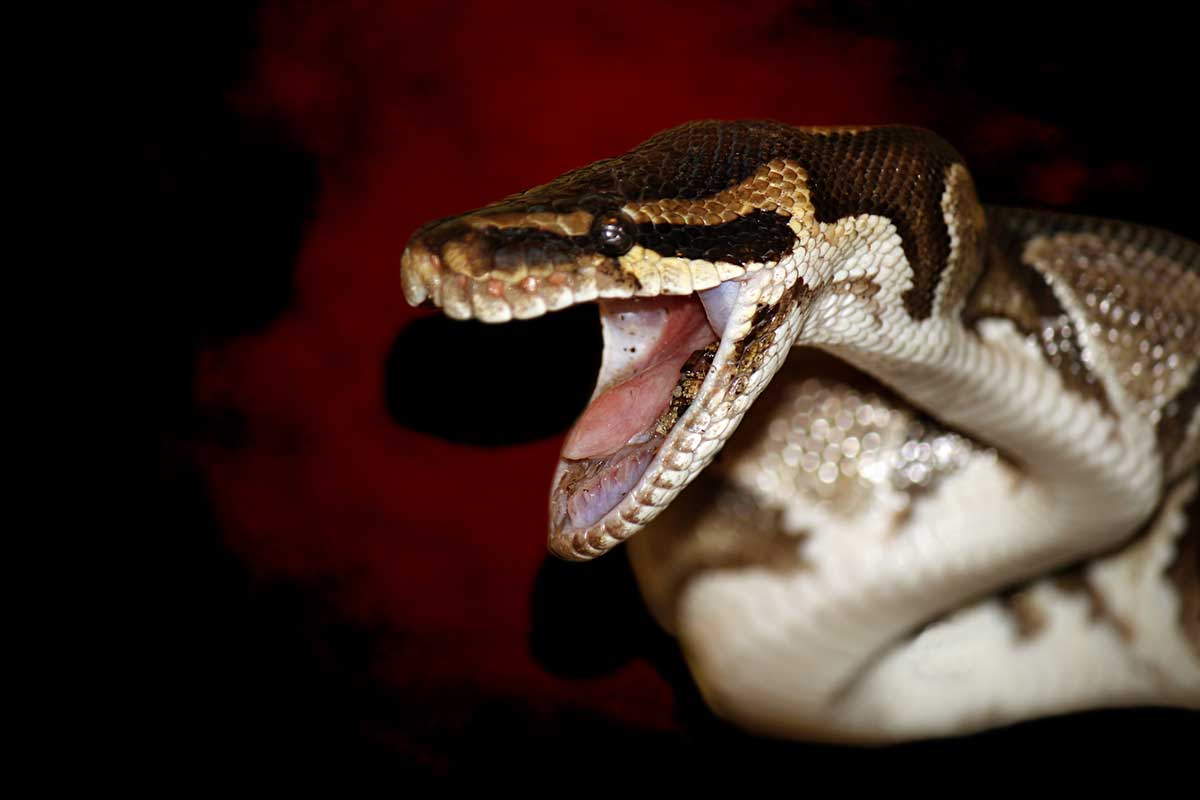Have you ever wondered how snakes breathe? Do snakes have lungs, and do they breathe like other mammals? And what about aquatic snakes—can they breathe underwater? The simple answer is yes to all of the above!
But the longer answer is not as simple as it may seem. Snakes do have lungs like mammals, but the act of breathing is different from other animals and their lungs look very different, too. Some aquatic snakes have even developed the ability to absorb oxygen through their skin.
So the simple answer has become rather complex, which is quite fitting for an animal as paradoxical as a snake. Snakes are fascinating creatures; they look slimy but are actually silky smooth to the touch. They are the stuff of nightmares but can be rather cuddly and cute.

Today, we’ll shed light on a creature that is so often shrouded in mystery and darkness and fully answer the question of how snakes breathe.
What Breathing Equipment Do Snakes Have?
Here, we’ll start at the top, or nose rather, and work our way down the respiratory system of an average snake to figure out what equipment they use and what the purpose is for each part.
Nose
At the tip of a snake’s snout is a pair of nostrils or slits that allow air in and out. The nostrils act in a similar way that yours do; they produce mucus to stay hydrated and provide a passage for air to enter and exit the snake’s body.
Fun fact: Snakes can seal their nostrils to prevent water from getting into them.
Glottis
The glottis is located at the back of the snake’s throat at the entrance to the trachea. It is a thin slit that the snake can open and close when it needs to breathe. The glottis can be closed or opened when the snake is eating so food doesn’t go down the wrong way, causing the snake to choke or suffocate.
Trachea
The trachea is also known as a windpipe. If you put two fingers on either side of your throat and yawn you will feel a hard pipe with ridges on it—that’s your trachea. Snakes also have a trachea that provides a passage for the air to travel from the nostrils to the lungs.
A snake’s trachea is a tube that is propped open with a number of cartilage rings that prevents it from collapsing. Your trachea is propped open in the same way.
The cartilage rings that prop open the trachea are able to bend and conform to external pressure to a certain point; however, if they’re damaged through force, they can close the trachea and cause the snake to suffocate.
Lungs
Snakes have lungs. However, their lungs are not like the organs you and I have. Like humans, a snake has two lungs, but if you think about the diameter of a snake’s body (quite small considering their length) it makes it comical to think about a mammalian setup in their ‘chests.’
Since a snake’s body is much longer than it is wide, evolution has accommodated for this and each lung runs along the majority of the length of the snake’s body. Some snake species have very simple long tubes for lungs while others have more complex systems.
How Does Oxygen Get From A Snake’s Lungs To Its Body?
The way humans get oxygen into their systems is very different from how a snake does it.
Human’s lungs are filled with small sacs called alveoli that look a little like bunches of grapes. Alveoli have thin walls with lots of blood vessels in them. Oxygen is able to pass through the thin walls of the alveoli and bind with the hemoglobin in the blood where it is then transported around the body.
Humans need the alveoli because they increase the surface area of the lungs so that the maximum amount of oxygen can get into the blood and carbon dioxide can leave it (i.e. respiration).
Snakes don’t have the bundles of alveoli in their lungs. The walls of the lungs are thin enough to allow oxygen and carbon dioxide to pass through them. A snake’s lungs are large enough that they provide enough surface area for respiration to take place.
How Do Snakes Breathe On Land?
Humans have a diaphragm under the lungs that pulls down and sucks air into the lungs. Snakes do not have a diaphragm.
Snakes have ribs that run the full length of their bodies until their tails begin. When they are on land and need to inhale, a snake will contract the muscles between its ribs, which pulls the ribs outwards.
At the same time, the glottis will open up and the trachea will elongate. This all creates a vacuum that pulls air into the lungs.
Snakes then use a process called buccal pumping, to ‘pump’ air into their lungs. They do this by opening and closing the glottis and moving the trachea up and down to create a pump-like motion, which draws more air in.
When the snake needs to exhale, they relax the rib muscles and open the glottis, and the lungs deflate much like a balloon.
Fun fact: Without your ribs, spine, and breast bone, your lungs would deflate like balloons, too!
How Do Snakes Breathe Underwater?
Snakes don’t have gills like fish and cannot breathe through their skin like some amphibians, but certain species are adapted to live an aquatic life.
There are a couple of small adaptations that allow some snake species to live in water:
- Reduced metabolism: A slower metabolism means less oxygen is needed to keep the body going.
- Larger lungs: Aquatic snake species have larger lungs than their land-based cousins, which means they can ‘store’ a lot more oxygen to last them long trips underwater.
- Nose valves: Aquatic snakes have valves in their noses that seal them off so they don’t lose air when they are under water.
The most impressive adaptation of some aquatic snakes, such as Hydrophis cyanocinctus, commonly called the annulated sea snake, for example, is a spot on the snake’s head between its nose and the top of its head where there is specialized skin and a network of blood vessels that allows respiration to happen.
The small spot allows oxygen to be absorbed and carbon dioxide to be expelled through the snake’s skin while they are under water. Only a small amount of respiration can happen through this specialized spot, and all aquatic snakes still need to return to the surface of the water to breathe through their noses.
Fun fact: Land snakes came first! Sea snakes only evolved around 16 million years ago from land snakes, whales are much older than sea snakes!
How Do Snakes Breathe While Eating?
By this point, we can probably agree that snakes are pretty awesome just for being able to breathe. They can do something humans can’t: They can eat and breathe at the same time!
Constricting
Constrictor snakes need to physically suffocate their prey with their coils and this can take a very long time. But if they’re using their muscles to coil around the prey, then how can they use the same muscles to breathe? They can’t hold their breath for what can be hour-long battles.
Constrictor snakes can identify the individual rib muscles (costal muscles) that are being used to constrict the prey and which are not. They can then manipulate their bodies so that some sections of their ribs are pushed out to inflate that section of the lung. Those sections of lung are being used to breathe while others are being used to constrict the prey.
Swallowing
Have you ever been eating and suddenly food goes down the wrong pipe and you end up choking, all because you were trying to breathe? Snakes have adapted a way to avoid this problem because their meals tend to drag on.
All snakes swallow their prey whole, which can take a very long time. They cannot hold their breath for this amount of time; however, they can’t exactly chomp their prey in half either to take a quick breath.
To solve this problem, these brilliantly creepy creatures are able to push their trachea partly out their mouths so they can breathe while they are swallowing their prey!
FAQs About How Snakes Breathe
Do snakes need oxygen to live?
Snakes need oxygen to survive, just like all animals. They need less oxygen than some other animals because their metabolic rate is slower, but they still need oxygen.
Can snakes breathe water?
As mentioned earlier, some snakes can ‘breathe’ through the skin on their heads while they are underwater for a very short amount of time. However, snakes cannot ‘breathe’ water (take water into their lungs) like fish pull water through their gills. If this were to happen, the snake would drown.
How long can a snake go without air?
All snake species are different and have different oxygen requirements. The more active the snake, the more oxygen they need. However, most snakes can hold their breath and go without oxygen for 15 to 25 minutes.
Aquatic snakes such as anacondas can go for a little longer between each fresh breath whereas land snakes that are not used to holding their breath may not be able to hold it for as long.
Do all reptiles have lungs like snakes?
Snakes are fascinating creatures and stand out even among bizarre and wacky reptile groups it calls family.
Most other reptiles have lungs that have some folds in them to create a greater surface area for respiration to take place. The more modern or advanced reptiles have separate chambers or branches in their lungs to increase the surface area and amount of gaseous exchange.
A reptile that is more active and has a higher metabolic rate will require more oxygen and is likely to be a species that has more developed lungs.
Do snakes breathe through their mouths?
Snakes don’t really use their mouths or tongues to breathe. A snake’s mouth usually stays closed, and their tongue makes an appearance every now and then to take scent particles back into the mouth and pass them over a scenting gland.
If you’re lucky, you may witness a snake yawn once in a while, but that’s usually just to stretch their jaw and realign their joints after a big meal rather than to take in a big breath.
Apart from the odd yawn, if you see your pet snake panting, it’s a sign that something is wrong and you should get them to a vet urgently.
Exhaling On How Snakes Breathe
For anyone who has ever wondered how snakes breathe, let’s do a quick recap of the whats, whys, and hows:
- Snakes have lungs that are long tubes that run down the majority of their bodies. These lungs have thin walls with lots of blood vessels, which allows for respiration to take place.
- While a snake is constricting prey, it can manipulate its ribs and lungs so specific sections expand and contract while others are used to hold on to the prey.
- Some aquatic snakes have developed a specialized spot on their heads where the skin is very thin and highly vascularized, which allows for the exchange of oxygen and carbon dioxide.
- While a snake is swallowing its prey, it can push its trachea part of the way out of its mouth so it can breathe and swallow at the same time.
There is no doubt in our minds that the simple task of breathing is a fascinating action when it comes to snakes!
- Why Do Guinea Pigs Purr? (Understanding This Behavior) - November 27, 2023
- Why Does My Cat Lick My Toes? (7 Reasons) - November 20, 2023
- Why Doesn’t My Cat Purr Anymore? Should I Be Worried? - November 13, 2023

